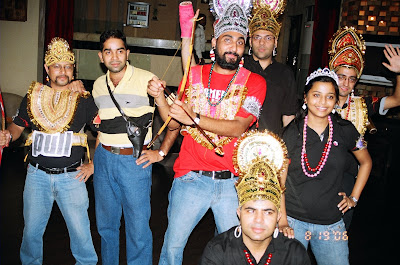
... is what you would see at the entrance of MakeMyTrip office; a hearty thought. There is something special about my former employer, MakeMyTrip, a start-up and the pioneer of travel distribution in India.
My folks would ask twice (on an average), when I told them where I work and what I do there (Mak-My Trip, Make Me Trip some bizarre versions).... E-commerce was new (well in 2004, not that new, as people bought books and cds on Indiatimes), and internet was buzzing. The bunch MakeMyTrip reflected this enthusiasm. Here's my recollection of the spirit, in pictures and worth 1000 words ( roughly 500 words for amateurs photographer such as I)...
1. Productions (Modern Ramayan would certainly feature): A general feature at the makemytrip offsites. We would normally run out of scripts and would finally resort to the good old "Modern Ramayan". The one in picture was staged in the serene locations of Malaysia, and one of our better productions. (featured in the picture from left to right is Deepender Rawat, Jasmeet Singh, Jitu, Mayur Oberoi, Amit Saberwal, Swapnil Gupta & Sidharth Grover).
 2. Offsites: At least twice in a year. The best part of the offsites were the interesting stories after offsites...
2. Offsites: At least twice in a year. The best part of the offsites were the interesting stories after offsites...

3. Visiting Cards: People could find our names (Oh I see your email ID, but where is your name) and didn't read the personalised interests. This would be one of the best B-Cards that I have seen till date...

4. "Trip with us" Wall Collage: is right at the entrance (I'm placed in Ethiopia)...

5. Meeting Rooms: Nicely adorned with the sign "Trip in Progress", where we "aimed" and "shot down" our competitors.

6. Festival celebrations: Colorful and full of zest. Not to forget the fountain in front of the office which was used extensively for Holi.

7. Painting and Wall Hangings: Some of these done by us at MakeMyTrip (the one on the LHS)...


8. "365 Days to Visit when you are alive" Notebook: True to it's name, took almost 365 days to finally print, but worth the effort. Each page had esoteric destination. Featured in the photograph is the Co-founder and CMO, Sachin Bhatia...

The only thing more important than the bottomline at makemytrip was celebration. It was a good trip!
Cheers!
Dushyant
























